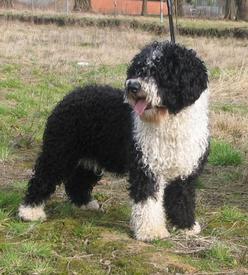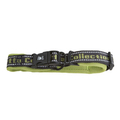
Many theories exist surrounding the origin of the breed, with some suggesting it was introduced to the Iberian Peninsula along with the Turkish merchants who moved, along with their livestock, throughout the Mediterranean, and others pin-pointing its development to North Africa. The earliest records of the breed date back as early as 1110 AD, being known by several names including the Perro Turco, Perro de Agua and the Perro de Lanes. Primarily bred to herd flocks, hunt upland game and waterfowl, and retrieve for the fishermen, the Spanish Water Dog was a very able dog, remaining in the Andalucian mountains and parts of southern Spain even after the Industrial Revolution saw many areas replacing the breed in favour of the heavier Belgian or German Shepherd Dog. Interest in the Spanish Water Dog has fluctuated throughout its existence; originally favoured by the French aristocracy and imported to Paris, the breed was forgotten with modernization, only being spared extinction by the efforts of two enthusiasts in 1975.
A dog of medium-sized build, with strong legs, a broad head and muzzle, long pendant ears and a deep chest for enhanced lung capacity. The double coat is typically curly, woolly and profuse with a wiry texture. It is often seen in colours of black ,white and chestnut, with tricolour variations being disallowed in the show ring. The appearance of the Spanish Water Dog reflects its versatile working capabilities; rustic and low maintenance, with a corded coat that requires minimal management, it is unsurprising the Spanish Water Dog has enjoyed such popularity throughout its development. The tail is held at a medium height and is traditionally docked, despite this being an illegal practice across Europe.
An intelligent and versatile breed, the modern Water Dog is utilised in bomb detection and Search and Rescue in its homeland Spain, equipped with keen senses, agility and vigilance. Despite its police usage, the breed possesses a warm and friendly temperament that suits it to any home setting; compatible with children and other house pets when introduced gradually, the Spanish Water Dog is the ideal breed choice for a family or dedicated sole owner. A healthy Spanish Water Dog will weigh an average of 14-22 kg with discrepancies across gender, and have a life expectancy of 10-14 years when shown the appropriate care.
Generally resilient and healthy, the Spanish Water Dog is not known to suffer from any serious, breed-specific ailments. No genetic or hereditary diseases are identified with the breed, although its relative rarity makes this difficult to ascertain. Due to the thick coat that covers its entire body, it is not uncommon for hair to grow within the delicate ear canal, leading to discomfort and infection. GM-1 Storage Disease, a rare condition affecting the nerve endings, is prevalent in the breed and is usually fatal.








From Buckinghamshire, United Kingdom
Friendly, well behaved, inquisitive and fun. Can be timid with strangers which is not a bad trait. Excellent with children and other animals, not frightened by loud noises or thunder. A really easy breed to live with, that rarely sheds so great for those who have fur allergies. Can't recommend this breed enough.
From North Ayrshire , United Kingdom
I just love Pedro my SWD and I am so glad I found this amazing intelligent breed of dog.However ,he can sometimes be challenging and needs clear instructions as to who is in charge. SWD past - present history is used in the Spanish mountains as a working dog herding sheep and goats. Therefore, they need lots of physical and mental stimulation on a daily basis,otherwise they can become board and start chewing items etc.SWD are extremely loyal,loving and very affectionate towards their owners. My advice to individuals who are thinking of buying a Spanish Water Dog as a family pet is that I would highly recommend that you throughly research this breed of dog before purchasing.
I hope this information is helpful to those who are thinking about this breed of dog
June Dalzell